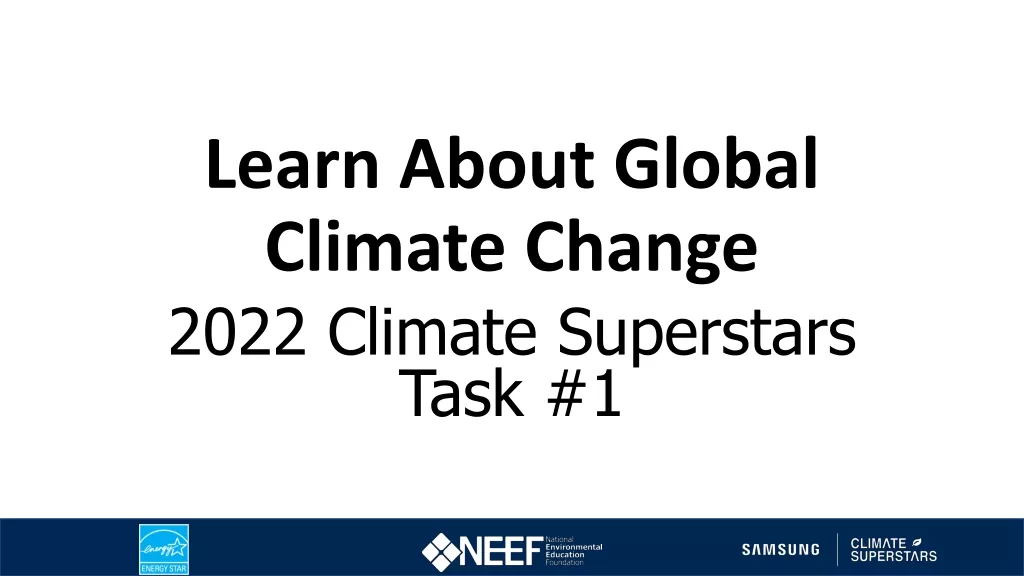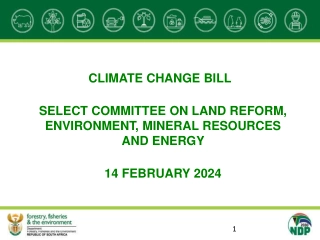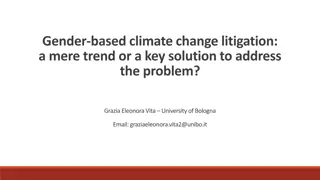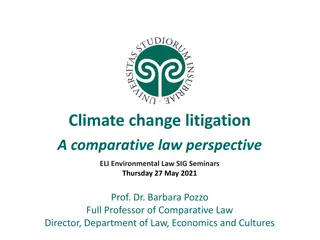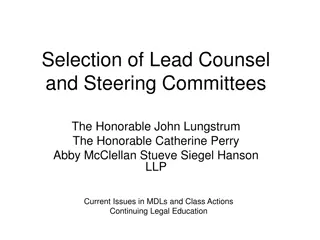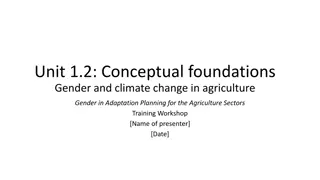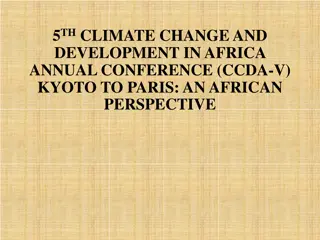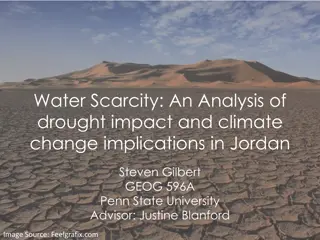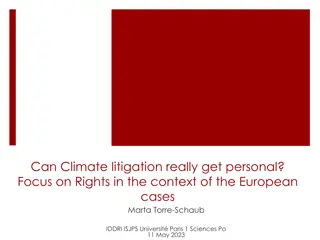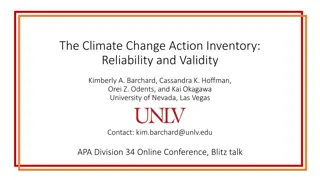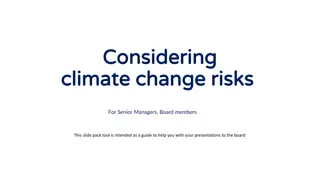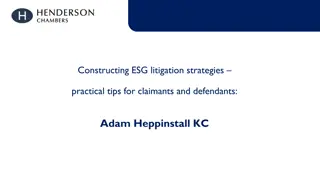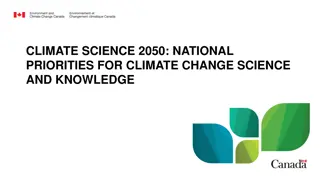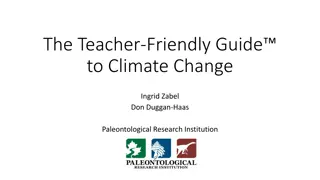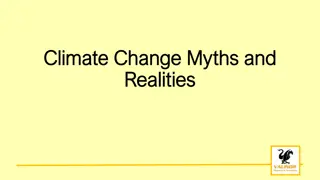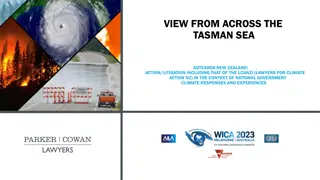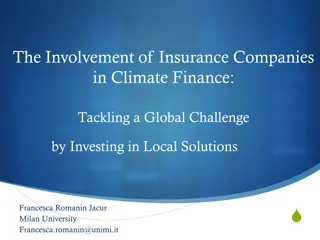
Climate Change Litigation Insights in Australia and the Pacific
Explore the impact of climate change litigation on the insurance sector in Australia and the Pacific region. Understand the regulatory developments, potential risks, and the role insurance entities can play in managing climate-related challenges.
Download Presentation

Please find below an Image/Link to download the presentation.
The content on the website is provided AS IS for your information and personal use only. It may not be sold, licensed, or shared on other websites without obtaining consent from the author. If you encounter any issues during the download, it is possible that the publisher has removed the file from their server.
You are allowed to download the files provided on this website for personal or commercial use, subject to the condition that they are used lawfully. All files are the property of their respective owners.
The content on the website is provided AS IS for your information and personal use only. It may not be sold, licensed, or shared on other websites without obtaining consent from the author.
E N D
Presentation Transcript
1 Climate change litigation in Australia and the Pacific: Insights for insurers MS REBEKKAH MARKEY-TOWLER, PHD CANDIDATE AND RESEARCH FELLOW, SUSTAINABLE FINANCE HUB, MELBOURNE CLIMATE FUTURES
Overview 2 1. Context 2. Climate change litigation 3. Regulatory developments 4. Potential insurance climate litigation
1. Context 3 Overarching goal of the Paris Agreement to keep the increase in the global average temperature to well below 2 C above pre-industrial levels and pursue efforts to limit the temperature increase to 1.5 C above pre-industrial levels . Already, average global temperatures between 2023 and 2027 are expected to be between 1.1 C and 1.8 C higher than pre-industrial levels (World Meteorological Organisation 2023). At best, the world is projected to warm by 1.9 C if all NDC and long-term pledges are met in full and on-time. However, taking into consideration only 2030 pledges, the best estimate of 2100 warming is much higher, i.e., 2.2 C- 2.9 C (Climate Resource 2022). What does this mean for the insurance sector?
1. Context 4 There are three primary transmission channels through which climate change might impact the insurance sector: 1. Physical risks: risks for insurance firms from weather-related events e.g. fires, floods and storms. These include direct impacts from the events (e.g. property damage) and indirect impacts from subsequent events (e.g. global supply chain disruption or resource scarcity). 2. Transition risks: risks for insurance firms associated with the transition to a lower-carbon economy (e.g. repricing fossil fuel intensive assets). 3. Liability risks: risks for insurance firms from parties who suffer loss and damage from climate change and then aim to recover from others who they believe to be responsible. Costs from these claims may then be passed to insurance firms e.g. third-party liability contracts like professional indemnity or directors and officers insurance. Source: Prudential Regulation Authority, The Impact of Climate Change on the UK Insurance Sector (2015); Bank of England, Results of the 2021 Climate Biennial Exploratory Scenario (2022)
1. Context 5 So, what role can the insurance sector play in climate change action? Insurance entities provide products and services that enable the transfer, pooling and sharing of risk necessary for a well-functioning economy. Insurance entities, through their products, can also create a form of moral hazard, reducing incentives to improve underlying behaviour and performance, and thus contributing to sustainability-related impacts (IFRS 2023). Essential characteristics of insurance are risk transfer and loss spreading: Todd v Alterra at Lloyds Ltd (on behalf of the underwriting members of Syndicate 1400) [2016] FCAFC 15 per Allsop CJ and Gleeson J at [38]. The insurance sector can therefore play a role in: Managing climate-related risks and opportunities e.g. Recommendations of the Task Force on Climate-related Financial Disclosures 2017. Transitioning portfolios and aligned with pathways to net zero emissions e.g. Net Zero Insurance Alliance launched in July 2021.
2. Climate change litigation 6 Defining climate change litigation: Cases where climate change is a central issue in the dispute, climate change is raised as a peripheral issue, climate concerns motivate the lawsuit, or the case has implications for mitigation or adaptation (Australia and Pacific Climate Litigation database). Cases brought in judicial settings e.g. courts and non-judicial settings e.g. legal letters, enforcement action. Australia is a hot spot for climate change litigation, second highest jurisdiction outside of the United States (Setzer and Higham 2023). Cases brought against governments but also corporations and investors.
2. Climate change litigation 7 Source: Setzer and Higham 2023, p.12
2. Climate change litigation 8 Australia as a test bed for corporate climate litigation. Corporate climate litigation: cases against or involving a corporate defendant; and/or utilising corporate causes of action in company, commercial or financial law (Peel, Markey- Towler and Shields 2023). Cases to hold corporations accountable for their contribution to climate change, to challenge their environmental representations, and/or to drive corporate energy transition and adaptation.
2. Climate change litigation 9 Climate change cases also being brought against financial sector participants e.g. bank, superannuation funds, asset manager: Abrahams v Commonwealth Bank of Australia: Documents sought by shareholders to assess CBA s statement that their business lending policies support the responsible transition to a net zero emissions economy by 2050, by only providing Banking and Financing activity to New oil, gas or metallurgical coal projects if supported by an assessment of the environmental, social and economic impacts of such activity, and if in line with the goals of the Paris Agreement . McVeigh v REST: Mr McVeigh argued his superannuation fund, REST, had breached their legal obligations by failing to disclose and address climate change risks, including that they failed to act with care, skill and diligence and in his best interests. ASIC v Mercer Superannuation and ASIC v Active Super: Civil penalty proceedings brought against Mercer and Active Super for allegedly making misleading conduct and misrepresentations about the sustainability of their investments. ASIC v Vanguard and infringement notice to Vanguard: Civil penalty proceedings brought against Vanguard Investments alleging misleading conduct in relation to ESG exclusionary screens, as well as an earlier infringement notice for greenwashing
3. Regulatory developments 10 Increasing attention from regulators and policymakers to ensure financial sector participants are acting on climate change. For example: Australian Government proposal to make climate-related financial disclosures mandatory for entities (including financial institutions) lodging financial reports under Chapter 2M of the Corporations Act (Consultation Paper 2023). ASIC s enforcement actions to address misleading conduct in relation to sustainable finance, including greenwashing (Enforcement Priorities 2023). APRA s Prudential Practice Guide on Climate Change Financial Risks and inaugural Climate Vulnerability Assessment with the banks. CFR 2022 stocktake reporting plans to potentially extend analytical work and vulnerability assessments to insurers and superannuation. Integrating climate risk into supervision activities. ACCC publishing draft guidance to improve environmental and sustainability claims made by businesses and to protect consumers from greenwashing. Work to develop an Australian sustainable finance taxonomy led by ASFI and supported by the Government.
4. Potential insurance climate litigation 11 Recent cases brought overseas against insurers in the United States: Everest Premier Insurance Co v Gulf Oil LP:Everest Insurance sought a declaration that none of the policies it had issued obliged it to defend or indemnify Gulf Oil in a lawsuit brought against the company. The lawsuit alleged that Gulf Oil had not properly prepared its petroleum fuel terminal for the impacts of climate change. The policy issued by Everest applied to payment for bodily injury or property damage. In 2022, Everest voluntarily dismissed their suit. Aloha Petroleum Ltd v National Union Fire Insurance Co of Pittsburgh: Aloha has filed an action for breach of contract and declaratory relief due to National Union s failure to cover Aloha for climate-related lawsuits. The lawsuits were brought against Aloha by the Country of Honolulu and Maui. The case is ongoing.
4. Potential insurance climate litigation 12 Underwriting Activities Policyholder claims due to physical, transition or liability risks e.g. construction of exclusion terms Investment Activities Misleading and deceptive conduct cases alleging greenwashing Governance Breach of proposed Financial Accountability Regime to impose accountability obligations on insurance, banking and superannuation industries(NB entity liability only) Director and officer liability for failure to manage climate- related risks and opportunities Complaints to the Australian Financial Complaints Authority (AFCA) about general insurance Complaints alleging unconscionable conduct and unfair contract terms Director and officer liability for failure to manage climate- related risks and opportunities Anti-competitive conduct through insurer collaboration e.g. backlash to NZIA in the US

